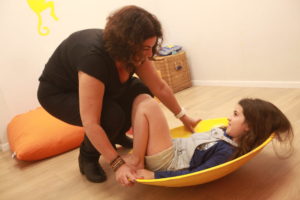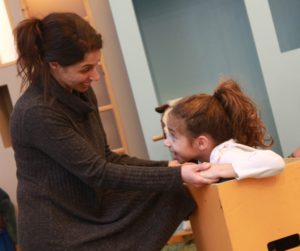General Description:
Affective agent is a therapeutic method in the Neuro-Geometric Approach. The parent or therapist serves as the child’s agent of sensory regulation, affectively tailoring voice, gaze, physical closeness, and movement in relation to the child’s level of sensory processing to facilitate co-regulation and engage the child in line creation. The therapist focuses on the child’s engagement and the quality of the interaction. They use cues tailored to the child’s sensory profile, such as tone of voice, facial and body movements, and rhythm, to produce or support the line (Vig & Wieder 2021, Vig, A., 2019).
When should an affective agent be applied?: When there is a desire to create a continuous interaction of the parent or therapist with the child.
Objectives:
- Promote bonding and synchronization between the parent, therapist or educator, and child
- Promote connection and interaction
- Strengthen the line between the parent or therapist and the child
- Promote interest and curiosity in the child.

Tools:
- The parent or therapist- the adult’s goal is to attract the child to an engaging interaction (unlike the affective container in which the primary goal is to regulate sensory processing). The parent or therapist consciously uses the self through gaze, touch, voice, intonation, rhythm, physical orientation, and gestures to encourage interaction.
- The affective facilitator is aware during the interaction of the characteristics of the line – length, distance, brightness, intensity, directions, axes (up, down, side to side, and diagonal), sensory modalities (visual, auditory, tactile, etc.), and continuity (a strong and flowing versus fragile line).
Guidelines
- Present yourself in front of the child in different ways using the emotional and sensorimotor profile of the child. Show yourself so that the child will be aware and curious about your presence in the situation. Arouse interest and curiosity through pauses or attentive waiting.
- Try to place yourself in front of the child. Pay attention to height, distance, and direction.
- Slow transitions suited to the child’s needs.

Key point:Ensure the child sees the affective facilitator before proceeding, using slow transitions with the tools presented above.
Examples:
Example 1 –
A child lies on the floor during treatment, plays with the car, and focuses on the spinning wheels. The therapist instructs the mother to lie next to the child and place herself in front of the child to create a short line between them. First, the mother synchronizes with the turns of the wheels by singing at a slightly faster pace to increase the sensory input the child experiences during play and participating in the child’s activity – “spinning, spinning, spinning”. Gradually the mother changes from a reclining position to a sitting position and takes the car (slightly lengthening the line between them). The child looks up at the car and mother, who commences driving the car from different directions towards the child. The interaction creates additional axes of the line through pleasing and entertaining play. The child notices his mother and enjoys playing with her and the car while developing a network of virtual lines.
Example 2 –
A father pushes his child on a swing in the playground. The child disengages from her father and reorients her focus towards her hands instead. The father attempts to form lines with various axes. A short line is created when the father arrives in front of the child and pushes her in combination with “wow” vocalizations. The father progresses to arrive at a different angle each time, successfully creating multiple axes of the line. Gradually the child retains focus towards her father, showing great enjoyment and a positive connection between her father and the swing.
Example 3 –
A teacher, serving as an affective facilitator, can encourage the child’s curiosity and learning by supporting his or her attention. For example, a teacher who sees a disengaged child can approach him and offer him “high fives” before returning to the lesson. She should then continue to engage him throughout the lesson by smiling at him or asking him questions, sustaining the line drawn between them. The affective regulation should be cultivated while maintaining the attention of the other children with the understanding that this child needs extra attention at this stage to keep him focused on the lesson (Vig, 2021).